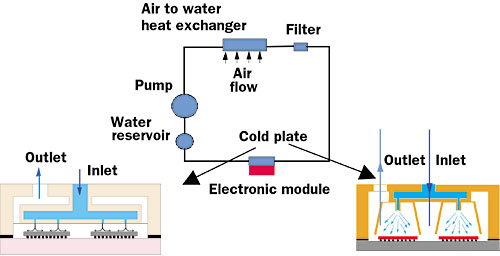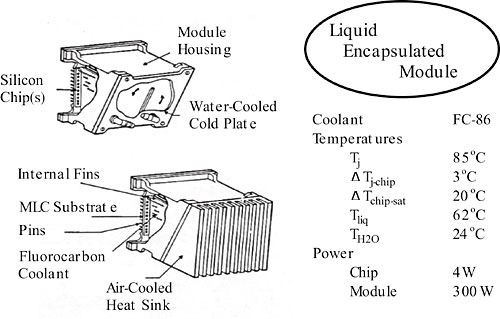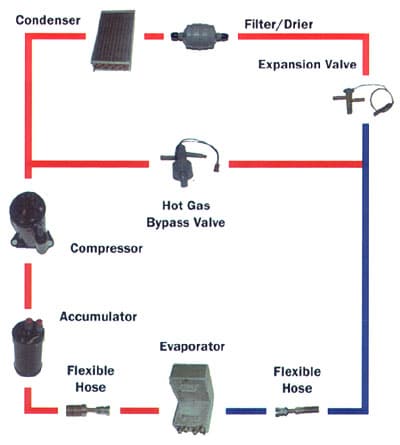(Editor’s Note: Part 1 of this article appeared in the August 2003 issue of ElectronicsCooling. Illustration references in this part begin with Figure 5.)
Cooling electronic systems is one of the major focal points of the design process and the key to a successful product launch. Many options to attain successful operation are available, ranging from passive cooling to cryogenics. These options are obviously power dissipation and heat flux dependent with many packaging, implementation and cost-of-operation issues. From a market success standpoint, the solution with the least operation and maintenance cost is the most desirable one. However, systems operation (device frequency) and packaging constraints often dictate solution alternatives that may not fit the least cost and maintenance model. Furthermore, there are many so-called “thermal limits” floating in the literature that recommend cooling based on power dissipation rather than device junction temperature. Therefore, it is the intent of this 2-part article to review commercially available cooling technologies and to cite select examples with their salient feature as beacons for what has been and can be attained.
In part 1 of this article, which appeared in the previous issue, we discussed: The Heat Dissipation Issue, Cooling Systems (both passive and active), Heat Sinks and Fan Sinks without Heat Pipes, Fluid Flow Management and Enhancement, Hybrid Cooling, and Thermoelectric Coolers (TEC).
Closed Loop Liquid Cooling
This is defined as a high capacity, high maintenance cooling system that uses liquid as the coolant and a heat exchanger for heat removal from the coolant. Figure 5 shows a schematic drawing and typical implementation of such a system [3].
 |
Figure 5. A closed loop liquid cooling solution. The module at the lower left employs liquid jet impingement cooling. The module at the lower right uses spray cooling and represents an SGI Cray design [3].Different packaging schemes may put these cooling systems in other categories, but, in general, the use of closed liquid loops distinguishes these cooling systems from others. The predecessor for this cooling technique and perhaps the first commercial introduction of closed liquid loops in modern electronics (beyond vacuum tubes) is the IBM Thermal Conduction Module (TCM). In this system, a series of spring loaded cylinders conduct the heat from chips to the cooling chamber. Such cooling solutions are currently used in high priced, large capacity computers that can allow for the types of packaging and maintenance required to run these system.
 |
Figure 6. A thermosyphon cooling system. (Courtesy of Thermacore Corp.)
Thermosyphons
These are heat “transport” systems that use gravity to transfer heat from the source to sink. Although they are transport devices because of their implementation, they can be put into a category of a cooling solution. Figure 6 shows one such a system. The features of the system can be summarized as follows:
- Requires no pump and reservoir/expansion tank, compared to closed loop cooling solutions.
- Can be made compact, so that the evaporator is the size of the module.
- Sensitive to orientation and internal fouling.
- Plumbed system, subject to shock/vibration, leakage, and potential dry-out.
Direct Immersion with and without Boiling
In these systems the electronics is immersed in a Fluorinert liquid or mist to transfer the heat from the source to the sink. These are high capacity cooling systems that were deployed with limited success in the industry. The most famous such system – and some examples are still in operation – is the Cray super computer. Theoretically, the methodology is perhaps the best technique because the heat source is in direct contact with a high thermal capacity coolant, thus eliminating the nagging interfacial and spreading resistances that are the direct by-product of conduction-to-convection cooling schemes. Figure 7, shows one such example of immersion cooling from IBM [4].
 |
Figure 7. IBM immersion cooling system with liquid or air cooled systems to remove the heat absorbed by the coolant [4].In these systems, depending upon the design and the choice of the coolant, boiling may occur. Research has shown that despite the high heat transfer offered by boiling, coolant fouling is a major concern with a poor reliability implication both for the coolant and the system where the fouling emanates. Irrespective, one can conclude that major packaging, cost, and reliability issues are associated with such systems.
Refrigeration Cooling Systems
This is a relative newcomer to the electronics industry, finding a home in high speed microprocessors. In these systems, sub-cooling is necessary to attain the desired device frequencies. Kryotech is one of the first companies to have introduced refrigeration cooling to the commercial market. Figure 8 shows such a system where a simple, yet novel concept – a refrigeration unit of a size that would typically be used in a dorm room – is used to cool a high-speed microprocessor. The evaporator of the refrigerator is placed on the microprocessor to maintain it at the desired temperature.
 |
Figure 8. The first commercially available refrigerated processor.
(Courtesy of Kryotech.)To implement a refrigeration cooled system, the cycle and process look very similar to what has been commercially available for many years, Figure 9 [3].
 |
Figure 9. The components required to form the refrigeration cycle.
(IBM High End Z-Server, [3].)A number of systems have come to the market that cover the full spectrum of products. These include individual PC level systems, rack level refrigeration for telecomm equipment, and high capacity (20kW) refrigeration systems. However, as much as the notion of sub-cooling is attractive for reaching the desired device frequencies, the issues of packaging, cost and reliability of mechanical systems continue to cast doubt on the use of such systems in commercial electronics.
Cryogenics Cooling
This is perhaps the last frontier in cooling. The system is immersed in cryogenic fluids (e.g., liquid nitrogen) for cooling of super high heat flux devices that require low operating temperatures. Despite a couple of failed commercial products, cryogenic cooling never found its application in the commercial market place. This failure was attributed to high operating cost, major reliability issues (thus multiple down times), and high product cost due to custom development.
Reliability issues are uniquely different as they pose the opposite problem to heat. At very low temperatures, material characteristics are different, and a host of new failure mechanisms with commercial materials are encountered. Therefore, to implement such a cooling system, a departure from conventional packaging is required. This causes a system to be costly for typical commercial use. Cryogenically cooled systems are typically associated with military and space electronics that can tolerate the high degree of customization and system cost.
Conclusions
In reviewing the broad scope of available cooling solutions, two points have become apparent.
- Systems with tremendous heat dissipation have been designed and successfully launched in the market place. Thus, a broad range of cooling solutions do exist. Barring some of the basic physics associated with cryogenics and boiling heat transfer, the underlying principles and fundamentals are also well understood. Therefore, when one is faced with a large heat flux at the device level or overall system power dissipation, a review of the literature and common practices is perhaps the best starting point.
- For every high capacity cooling system, whether hybrid or refrigeration cooling, the biggest bottleneck is the packaging. High capacity cooling solutions do require a departure from conventional packaging techniques used in the commercial (large market) electronics. This is a matter that cannot be taken lightly since for the commercial electronics, least-time-to-market and product-cost are the two primary drivers.
To expand on the second point, although there are many excellent works taking place to advance the cooling options, e.g., acoustic compression (replacing mechanical compressors), thermionics, device level electronic refrigeration, etc., the commercial electronics market is basically cost driven. Thus, air cooling and options to enhance its capacity should not be overlooked. Often, some upfront engineering may avoid the large challenges of high capacity cooling solutions for a market that is not acclimated to these requirements. Considering that the selection of a cooling system is market driven rather than a matter of best practices, the successful design is the one that gets the product into the market first with the least cost.
References for Parts 1 and 2
- Mudawar, I., “Assessment of High-Heat-Flux Thermal management Schemes”, Proceedings of ITHERM, Las Vegas, NV, USA, 2000.
- Simons, R., “Application of Thermoelectric Coolers for Module Cooling Enhancement”, ElectronicsCooling, Vol. 6. No. 2.
- NEMI 2000, Electronics Industry Roadmap, VA, USA.
- Chu, R., A personal communication.






